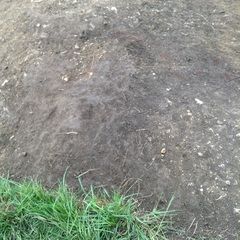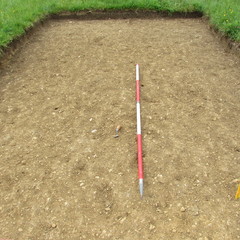Basic Information
- The earliest feature in the trench is an artificial layer construction (F601). It was composed of a light reddish-brown silty sand (ratch) visible in the section of a ditch (F602). This is likely to have been created by digging up the surrounding sub-soil (ratch) to create an artificial structure correlating with the construction of the mound structure observed in Trench 7 (F701) and is likely to be contemporaneous. On top of this layer was a hardcore cap (F603) constructed of a yellowish-brown sandy clay with medium sub-angular stones moderately sorted. This was then capped with a brown clay (F604) as an apparent waterproof layer. Together these layers formed an outer and inner bank. The banks were marked on the archae-topographical and magnetometry survey and must be a direct correlate (Fradley et al, 2014).
Contexts
Narrative
-
- The mound appears to have been constructed as out of earth (F601) consisting of mid greyish brown silt (6018) visible in an overcut section underneath [6010] below hardcore cap of the bank containing a few small fragments of bone, charcoal, and green glazed pottery. It is probably contemporaneous with 7020. The mound was overlain with a hardcore cap (F603) constructed of a yellowish-brown sandy clay with medium sub-angular stones moderately sorted (6006), (6009), (6021), (6023). This was then capped with a brown clay (F604), (6003), (6005), (6009), (6020), as an apparent waterproof layer to the mound. The bank was marked on the archae-topographical and magnetometry survey and must be a direct correlate (Fradley et al, 2014).
-
- Stuart Noon
- 22-7-2019
Dating Narrative
-
- 1570's
-
- Stuart Noon
- 22-7-2019


